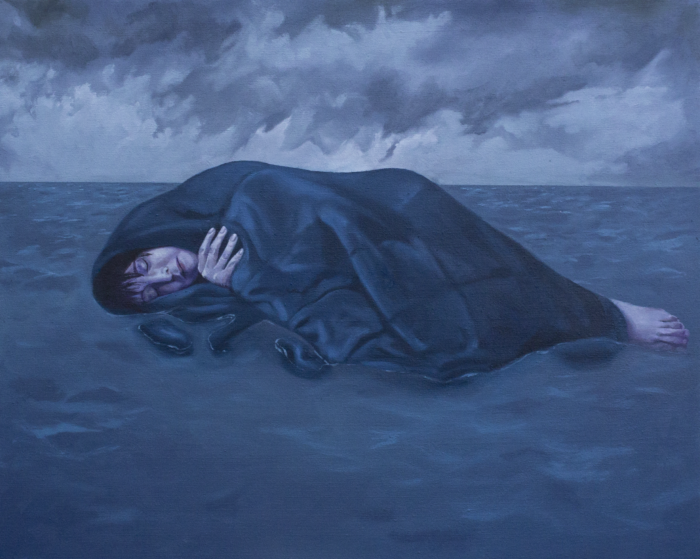New Art Writing by Celeste Cares, on the work of Charlene Denief
Essay available in LARGE FONT
Walking Away From Yourself: An Artist’s Journey Through Mental Illness
by Celeste Cares
Eyes closed, asleep perhaps, her hand clutches at the blanket wrapped around her head and crumpled body. A blue-gray sea and dark, cloudy sky surround her. Lying on her side, she appears to be floating, as if she were her own island. The blanket, her one protective totem, doesn’t cover her feet, and small waves lap at her icy toes. But she doesn’t care. She’s too numb to notice. She’d rather live unconsciously.
For those who’ve experienced depression and anxiety, this scene feels familiar. This is a painting of someone who has surrendered. It is the deep fatigue and isolation of depression, a giving in and giving up of effort. It is the innate drive towards self preservation, even when facing life feels impossible. How long has she been there? How long will she stay? The choppy sky and empty horizon speak to an eternity. She is a painting, after all. It will not be hard for her to stay there forever.
A painting can spend an eternity in unconsciousness, but for people, it is not so easy. Charlene Denief’s first solo show, Walking Away From Yourself, began growing its roots in 2011, when the artist suffered a mental health crisis after years of struggling with depression and anxiety. Denief was admitted to a day treatment program, which helped her to stabilize, and soon she took part in a youth arts program at the Murphy Center. It was there that she began experimenting with oil paints, and with increased introspection and experimentation in her sketchbooks, the first inklings of this show were born.
Over the coming years, Denief’s initial ideas about the show would adapt and evolve with her. “I didn’t think I’d live to 25,” she says, “as my anxiety was so crippling I couldn’t work or function. Now I’m a college graduate working professionally in a creative field, married, and volunteering with arts and tech organizations.” Ten years later, the final incarnation of Walking Away From Yourself is a way for Denief to share her experience from a place of recovery. “It was a long and bumpy road and there are still hurdles left to overcome,” she says, “but I have a good support system and this show has reminded me that I have overcome hardships and come out the other end better for it.”
Mental illness is often an incredibly private and emotional experience, and translating it into words can sometimes feel like a cheapening. Where words fail, Denief creates feeling. A pair of hands pick at themselves in a pool of water; women wait in darkness, eyes concealed by grief, fatigue, and confusion. Walking Away From Yourself brings viewers in close, coming face to face with the subject and her memories. Empathizing, viewers experience an honest expression of depression and anxiety, transformed into images that are somber, quiet, and sensitive.
For those who’ve known mental illness, seeing these experiences externalized can be therapeutic. Denief depicts herself and her experience with honest vulnerability, affirming the humanity of struggling with mental illness. But the work is also commemorative, encouraging us to let go. “I’m walking away from the person I was, into the future that I am now,” says Denief. “It was good to sit down and reflect on where I have been and what I have felt.” Like reading a diary in hindsight, Walking Away From Yourself honours the truth of what we’ve been through, so that we can better see how far we’ve come.

Celeste Cares is a multidisciplinary artist living in Nova Scotia’s Annapolis Valley. She studied painting at NSCAD University, graduating in 2020. Lately, much of her time is spent making jam, music, and art. She loves to write, too, because it helps her sanity.
